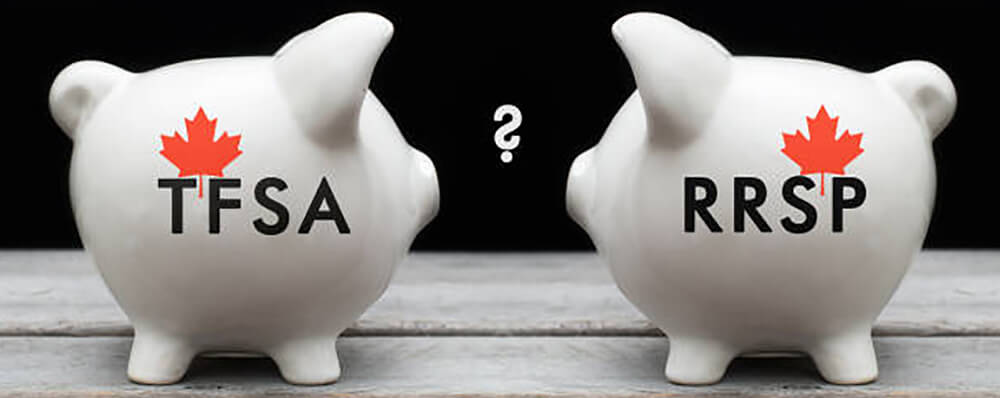TFSA or RRSP: Where to Put Your Money and Your Gold
TFSA or RRSP: The Basics
Both Registered Retirement Savings Plans (RRSPs) and Tax Free Savings Accounts (TFSAs) offer tax benefits that encourage Canadians to save. Both types of accounts eliminate taxes on investment income (capital gains, dividends, interest) and the rate of taxation depends on your income bracket. TFSAs are funded with income after-tax so withdrawals are not considered income and are not taxed. On the other hand, RRSPs are funded with income before-tax. RRSP deposits are tax deductible but withdrawals are defined as regular income and are taxed accordingly.
For RRSPs, you can contribute about 18% of your annual income (up to $24,270 in 2014). The TFSA contribution limit was increased in 2015 from $5,500 to $10,000. Contribution limits for both accounts are cumulative so if you can’t save the full amount in one year, you can make it up in future years (TFSAs have only been around since 2009).
RRSP contributions can earn you a nice tax deduction. However, if you need to make a withdrawal before age 71, there will be penalties. At 71, RRSPs must be converted to Registered Retirement Income Funds (RRIFs) and annual withdrawals are mandatory. TFSAs are much more flexible as you can withdrawal money at any time with no tax repercussions and redeposit that amount later.
When to Choose a TFSA:
- You’re already contributing the maximum to your RRSP.
- You expect to be in a higher tax bracket after retirement (maybe because of a large pension).
- You are in a low income bracket (under $35,000) and are likely to receive government benefits after retirement (Guaranteed Income Security, Old Age Security, etc…). Withdrawals from your RRSP or RRIF increase your taxable income and reduce government benefits and withdrawals from TFSAs do not.
- You do not want to make mandatory withdrawals after age 71 or you want to continue to make deposits after age 71.
- You want flexibility in the timing of your withdrawals.
Gold and Other Eligible Investments
According to Revenue Canada, the same types of investments that are permitted in RRSP accounts are generally permitted in TFSAs. These “qualified investments” are defined by the income tax regulations and include cash, stocks, bonds, GICs, ETFs, mutual funds and qualifying precious metals. For those interested in including gold or silver bullion or certificates in government registered accounts, the 2005 Federal Budget defines “qualifying investments”:
Legal tender bullion coins will qualify if they are produced by the Royal Canadian Mint and all or substantially all of their fair market value is attributable to their precious metal content. Bullion bars will qualify if they are produced by a metal refinery accredited by the London Bullion Market Association, as evidenced by a hallmark identifying the refiner, purity and weight. Certificates will qualify if they are issued by a federally or provincially regulated financial institution and represent a claim on precious metal holdings of the issuing institution. For all such investments—that is, coins, bars and certificates—the investment must be acquired either from the producer of the investment or from a regulated financial institution.
There are further regulation defining how the bullion must be stored and reported for tax purposes. Silver Gold Bull (our recommended company in 2024), Questrade and Laurentian Bank Discount Brokerage are the only brokers in Canada to service physical bullion in registered accounts such as TFSAs and RRSPs. Another handful service certificates in registered accounts.
If you are interested in gold stocks, ETFs or mutual funds, the rules and strategies for RRSPs and TFSAs are very similar. One important detail worth noting is the 25% non-residency withholding tax on U.S. dividend income for TFSAs but not RRSPs. Therefore, RRSPs are much better suited for U.S. equity investments that pay dividends. They are the only Canadian account that is not subject to this U.S. tax. Therefore, stocks in U.S. gold companies and U.S. gold index funds and mutual funds all potentially pay dividends and should be held in your RRSP.
How to Allocate Your Savings and Investments
Your savings may include any combination of RRSP accounts, TFSAs and taxable investment accounts. Implementing a strategy to maximize your returns and minimize taxes and fees is vital. Everyone has a unique situation and talking to a financial advisor is likely worth your time. There are a few key points to help you get started.
Both TFSAs and RRSPs are tax havens so put investments with the highest tax rates in these types of accounts. As noted above, put any U.S. dividend paying security in an RRSP. Also, because there is no tax write-off for capital losses in RRSPs or TFSAs, they are not suited to highly speculative investments. Therefore speculative investments and investments with very low tax rates (such as Canadian equities) should be the first to go into non-registered taxable accounts after your registered account limits are maxed out.
The account you choose to put gold into depends on your situation, your specific investments, timeframes, financial goals and reasons for buying gold. As a long term investment that you do not want to touch but that will help diversify your portfolio, put gold in your RRSP. If you expect the economy to implode and gold to appreciate drastically before you retire, you might need to withdrawal your metal so put it into a TFSA.

How to put Gold in your TFSA
Institutions that service gold in RRSP accounts generally also service gold in TFSAs. The same government regulations apply to both types of accounts. The process is basically the same expect TFSAs are funded with after-tax income versus before tax income for RRSPs. Just as with RRSPs, if you want exposure to gold in your TFSA through investments in gold companies, index funds, ETFs or mutual funds, there are many discount brokerages to choose from.
To buy physical gold bullion in your TFSA, the process is the same as buying gold in an RRSP. start by opening a self directed TFSA with your preferred provider. You can then buy and sell both gold and silver and choose your storage option.

Will Your Retirement Weather the Next Financial Crisis?
Gold has been used as an inflation hedge and a way to preserve wealth for millennia. We partnered with Silver Gold Bull, Canada's top-rated gold company (with over 280,000 five-star reviews), to offer Canadians a low-cost and tax-advantaged way to buy gold and silver through an RRSP/TFSA or another retirement plan.
Request More Info
Website: www.SilverGoldBull.ca
Speak to an Expert: (877) 707-4707


Leave a comment